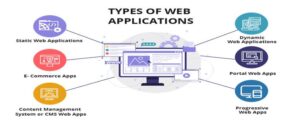Web presence has been crucial to building your brand and gaining credibility to attract more users and generate a higher ROI. Many top entrepreneurs and businesses, including Uber, Amazon, and Starbucks, use web applications. Have you ever wondered what kind of web app would be best for your enterprise business? Do notbe worried. In this article, we have discussed what a web application is and the various Types of web applications, so you will know exactly which web app type will meet your requirements.
What is Web Application?
Web applications are software applications stored on a server from any browser, like Google sheet, that can access from any web browser. The development of Web applications is not restricted to cell phones or tablets; instead, this kind of utilization is designed to run on any browser, on fixed PCs, or cell phones. These web applications are robust, scalable, and reliable compared to a website.
Different Types of Web Application
We have listed down the top web application development types and their characteristics and applicable industries. Choose the one, which meets your business requirements, the most.
- Static web applications
If you decide to create a static web app, you should be aware that it will display very little content and will be limited in its flexibility.
They are usually developed in HTML and CSS. However, animated objects such as banners, GIFs, videos, and so on may be included and displayed in them. They can also be created with jQuery and Ajax.
Professional portfolios and digital curriculums are two examples of static web application development.
- Dynamic web applications
On a technical level, dynamic web applications are far more complex. They load data into databases, and their contents are updated each time a user accesses them. They typically include an administration panel (called a CMS) from which administrators can correct or modify the app’s content, such as text and images.
Many different programming languages can be used to create dynamic web applications.PHP and ASP are the most common languages used for this purpose because they allow you to structure the content.
- Single-Page Applications
Because of the limited amount of information, single-page applications allow clients to communicate with the website page without difficulty. Requests and responses occur effectively. SPAs are faster than traditional web applications because they perform logic on the internet browser rather than the server. SPAs are simple to create, debug, and deploy, resulting in a smooth and quick experience.
Because of the customer side of logic, execution SPAs figured out how to satisfy and keep up with the promise of their name. They unquestionably allow clients to interact with a web application from a single page freely. Furthermore, the interaction and connection are much faster, as requests and responses impart small amounts of information and occur almost instantly.
Typically, any single-page application can be updated according to the needs later in the future. On the other hand, single-page apps are incompatible with SEO regulations due to the use of universal URLs. As a result, this web application is not appropriate for e-commerce. However, single web applications and agility can benefit social networks, e-mail services, and online video/audio players.
Examples: Gmail, Google, Trello, Google Maps, Twitter etc.
- Multi-Page Applications
Multiple page apps are web apps that include multiple pages and reload the entire page whenever the user navigates to a different page.
For example, when you log in to Amazon to buy a mobile phone, you must first click on a specific mobile phone; once you add a phone to your cart, press the following button. The web app will redirect you to the next page; finally, you must click on buy and be redirected to the cart page to complete your order.
Companies such as Google Docs and Trello provide various services and products. As a result, they allow their users to interact with the application in various ways. As a result, they opt for multi-page applications.
5. Animated Web Apps
An animated web app is a web application that supports animation and synchronization on a web platform. Sqadeasy and Miki Mottos are two excellent examples of animated web apps.
SVG, HTML5, CSS, and JavaScript are typically the best solutions for creating animated web apps.
- Progressive Web Apps (PWA)
PWAs are among the most well developed type web applications that resemble mobile apps. Users can access all of the data and features that improve the web application’s performance and mobile adaptability by using any mobile browser.
PWA is a modified version of the SPA, which is true in practice.
The primary goal of PWAs is not to introduce new architectural rules but rather to improve the speed and flexibility of web applications in the face of slow/lousy internet connections. The main improvements are cashing, better data transfer over HTTP/2, and home screen installation.
Examples: Starbucks, Forbes, OLX, MakeMyTrip, etc.
- Content Management Systems
A content management system enables the creation, modification, and management of content without technical knowledge. You don’t even need to know how to code or markup languages. A content management system (CMS) can be oriented to either blogging or general web publishing.
CMSs are well known for their use in personal blogs, corporate blogs, media outlets, etc. Some examples of popular content management systems are:
WordPress is without a doubt the most popular content management system available. There is a wealth of information, tutorials, and guides available on the internet to assist you in customizing it and comprehending how it works. Aside from that, it is completely free.
Joomla is the second most popular CMS after WordPress. It does not have as many users as the latter, but it does have a strong community and is also very user-friendly.
Drupal is a free and open-source content management system (CMS). It is very adaptable and is especially recommended for community building.
- E-commerce apps
If the web application is an online shop or store, the development process will most likely be similar to that of an e-commerce or e-commerce site. The development process for this type of app is more complicated because it must support electronic payments via PayPal, credit cards or other payment methods.
The developer must also create a management panel for the administrator. It will be used to add new products, update or delete existing ones, and manage orders and payments.
Electronic funds, inventory management systems, mobile commerce, the internet market, and supply chain management are all used in e-commerce.
- Portal web apps
Portal web applications enable organizations and their processes to scale by providing personalized access and user-centric navigation based on users’ needs. Some examples of portal apps include client portals, patient portals, and education university portals.
By portal, we refer to a type of application in which we can access several of its sections or categories via a home page.
Examples: Insurance and Online Banking Portals, Government Portals, Education University Portals Student & Faculty Portals, Employee Portals, Patient Portals, etc.
- Rich Internet Apps
Rich Internet Applications (RIAs) are a type of web application development that has some of the functionality of desktop applications but is faster and more engaging with better data communication. RIAs are familiar with overcoming browser restrictions, and they rely on customer-side plugins such as Flash, Shockwave, and Silverlight.
The two main issues with RIAs are the inconveniences they create and the vulnerability they create. Assume the plugin is obsolete; at that point, a few parts of the application or the entire application will not function correctly. These applications can even be used while not connected to the internet.
AJAX, Java, JavaFX, Adobe Flash, Adobe Flex, Adobe Integrated Runtime (AIR), Google Gears, Microsoft Silverlight, and Curl are some technologies used to create RIAs.
Examples: Google maps, Youtube, Google.
- JavaScript Powered Web Apps
With the advent of front-end JavaScript frameworks such as Angular.js, React.js, Meteor, and Ember Node.js, among others, there has been a shift in web-app logic from server-side to client-side, allowing for even greater flexibility and adaptability than occasionally embedded AJAX.
Client-side logic has begun to take over server-side tasks such as processing and handling user requests and rendering responses. These JavaScript-based web applications perform well, provide various levels of user interaction, and are search engine optimized.
Examples: Client-Portals, Business-Centric Web Applications, etc.
Click Here for- Web Development
Conclusion
It is difficult for a single web app to meet all of the needs of an organization. Various types of web application development are suitable and appropriate for various organizations. As a result, it is critical to assess your requirements and make an informed decision regarding web application development.
For example, E-commerce businesses are more likely to use e-commerce web applications. Educational institutions prefer portal web apps. As a result, the web app you choose should be based on your business type and target audience.
The article can help you navigate the selection process. If you cannot locate a suitable web application, you can always seek the assistance of a reputable and experienced Nashville web design company.
FAQ
- Q. What technologies are used in the development of web applications?
According to W3Techs, 97.5 percent of web apps are powered by JavaScript. In addition to JavaScript, we use the following web technologies to create modern web application solutions.
- Django
- CodeIgniter
- Yii PHP framework
- Microsoft .Net framework



